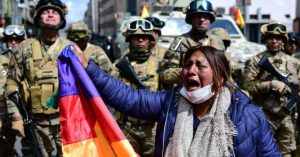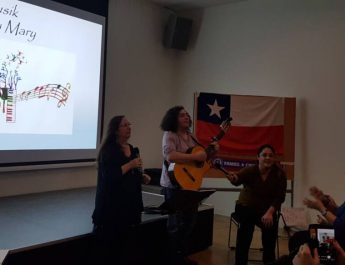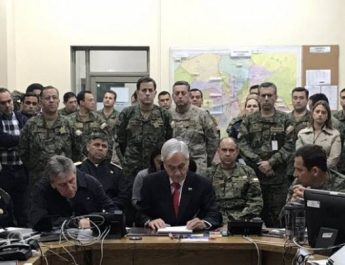November’s coup in Bolivia is just the latest episode in the right-wing resurgence across Latin America. In this article, William I. Robinson looks at the deeper structural causes for the retreat in the Pink Tide, and the hopes for a socialist renewal in the region.
The mass popular struggles sweeping Latin America against a resurgent neoliberalism and far-right aggression present the global Left with a peculiar paradox, coming at a time when the institutional and party Left has lost the hegemony it had previously conquered and is now all but in tatters. Any attempt at explaining this paradox must start by placing the current moment of popular rebellion within the larger backdrop of the political dynamics of global capitalist expansion and crisis in the region in recent years.
Global capitalism is currently facing an organic crisis that is both structural and political. Structurally, the system faces a crisis of overaccumulation and has turned to a new round of violent and often militarized expansion around the world in search for fresh opportunities to unload surplus capital and stave off stagnation. Politically, the system faces a breakdown of capitalist hegemony and crises of state legitimacy. As popular discontent has spread, the dominant groups have turned to ever-more coercive and repressive forms of rule around the world, both to contain this discontent and to force open up new opportunities for accumulation through an intensification of neoliberalism.
Nowhere is this dual crisis more apparent than in Latin America. The November coup d’état in Bolivia, the early October uprising against neoliberal restoration in Ecuador, the sustained rebellions in Haiti, Chile (the latter the very cradle of neo-liberalism), and now Colombia, the return to power of the Peronists in Argentina and just weeks later the electoral ouster of the leftist Broad Front in Uruguay, among other recent developments, all point to a season of great flux and uncertainty in the region. But these current upheavals must be placed within the broader political dynamics of capitalist globalization.
A Pink Tide Post-Mortem?
As Latin America became swept up into capitalist globalization from the 1980s and on it experienced a vast transformation of its political economy and social structure. After the dominant classes managed to beat back the revolutionary movements of the 1960s and 1970s, a new breed of transnationally-oriented elites and capitalists led the region into the global age of hothouse accumulation, financial speculation, credit ratings, gated communities, ubiquitous fast-food chains, and malls and superstores that dominate local markets in emerging megacities. These transnational elites and capitalists forged a neoliberal hegemony in the 1990s and undertook sweeping privatization, liberalization, deregulation, and austerity. Yet capitalist globalization aggravated poverty and inequality, displacing tens of millions from the popular classes, producing mass under- and unemployment, and triggering a wave of transnational migration and new rounds of mass mobilization among those who stayed behind.
The leftist or Pink Tide governments swept to power in elections early in the new century on the heels of mass rebellions against this juggernaut of capitalist globalization. The turn to the Left in Latin America raised great expectations and inspired popular struggles around the world. Hugo Chavez’ call for a 21st century socialism sparked hopes that the region could point the way towards an alternative to global capitalism. The Pink Tide governments challenged and even reversed the most glaring components of the neoliberal program, redistributed wealth downward, and dramatically reduced poverty and deprivation. Yet the structural power of transnational capital, and especially of global financial markets, over the effort by states and social movements to undertake transformations is enormous and pushed the Pink Tide states to accommodate these markets. Leftist rhetoric aside, the Pink Tide governments based their strategy on a vast expansion of raw material production in partnership with foreign and local contingents of the transnational capitalist class.
With the exception of Venezuela during the height of the Bolivarian revolution, what stood out was the absence of any shift in basic property and class relations despite changes in political blocs, a discourse in favor of the popular classes, and an expansion of social welfare programs financed by taxing corporate extractive industries. The spread of transnational corporate mining and agroindustry brought about a greater concentration of land and capital and heightened the structural power of global markets over leftist states. As a result, the Pink Tide countries became ever more integrated into the transnational circuits of global capitalism and dependent on global commodity and capital markets.
The popular masses were clamoring for more substantial transformations. The turn to the left did open up space for these masses to push forward their struggles. Yet states often suppressed demands from below for deeper transformation in their drive to attract transnational corporate investment and expand extractivist accumulation. These states demobilized social movements, absorbing their leaders into the government and the capitalist state, and subordinated their mass bases to the left parties’ electoralism. Because there were no more substantial structural transformations that could address the root causes of poverty and inequality, social programs were subject to the vagaries of global markets over which the Pink Tide states exercised no control.
Once the 2008 world financial crisis hit, they came up against the limits of redistributive reform within the logic of global capitalism, as many critics have analyzed. The extreme dependence of Pink Tide countries on raw materials exports threw them into economic turmoil when, starting in 2012, global commodities markets collapsed. These countries experienced extraordinarily high growth rates so long as the global economy was expanding and commodities prices remained high as a result of China’s voracious appetite for the region’s raw materials exports. The downturn undermined governments’ abilities to sustain social programs, leading them to negotiate concessions and austerity with financial elites and international agencies, such as happened in Brazil, Argentina, Ecuador, Nicaragua, and elsewhere. The resulting political tensions helped fuel popular protest and open up space for a right-wing resurgence. While Pink Tide countries cannot be painted with one broad stroke, these are essential elements of a background analysis to the recent coup in Bolivia, the ouster of the Workers Party in Brazil, and other Pink Tide reversals.
The Return of the Right
The traditional ruling classes were forced early on in the Pink Tide process to arrive at a modus vivendi with leftist governments given the balance of social and class forces. But just as soon as economic crisis and political turmoil opened up space for the Right’s maneuvering, the traditional ruling classes moved onto the offensive, often violently, in an attempt to recover direct political power. The constitutional and extra-constitutional turn to the right started with the 2009 coup d’état in Honduras. This was followed by the “soft coup” in 2012 against leftist President Fernando Lugo in Paraguay; the electoral ouster in 2015 of the Peronists in Argentina; the “parliamentary coup” in Brazil 2016 against the governing Workers Party; the return of the Right in Chile in 2017 with the election of President Sebastién Piñera and his Chile Vamos coalition; the election in Colombia in 2018 of the far-Right President Ivan Duque, who is but the titular face of the fascist Uribista project; and the electoral defeat in early 2019 of the Farabundo Marti National Liberation Front (FMLN) in El Salvador.
This sharp turn to the right has involved an escalation of repression throughout the region and a mobilization of far-right parties and business groups, culminating most recently in the October coup in Bolivia, as the region seems once again to be settling into authoritarian regimes. Latin American is becoming a cauldron of state and private violence fused together for the purpose of repressing the popular revolt and opening up the continent to further corporate plunder. Central to this far-Right turn has been a racist, authoritarian, and militaristic retrenchment to consolidate and expand transnational corporate power.
But the writing was already on the wall before the Right recovered direct political power. Latin American militaries have rapidly expanded in recent years in lockstep with a new round of transnational corporate and financial expansion in the region. Spaces that until recently exercised a modicum of autonomy, such as indigenous highlands in Guatemala and Peru, areas of the Amazon, and Colombia’s Pacific coast, are being violently cracked open and their abundant natural resources and labor supply made available to transnational capital.
According to a 2018 report by the Washington D.C.-based Inter-American Dialogue, “Security for Sale,” in 2017 over 16,000 private military and security companies in Latin America employed some 2.4 million people and often collaborated with state forces in repressing social movements. The lines between current and retired military and police personnel and these private companies are blurred, involving “an interwoven network of current military, former military, private security, business elites and government officials.” The Brazilian, Bolivian, Mexican and Venezuelan militaries doubled in size in recent years, and Colombia’s military quadrupled. The rest of the region’s militaries have grown in size by an average of 35 percent. Militaries have been deployed to the region’s megacities and often work alongside shadowy death squads in social cleansing and the repression of organized dissent.
The Right is now attempting to utilize the direct political power it has recovered to violently impose a full restoration of neoliberalism as part of this militarized expansion of transnational corporate plunder. It was this new round of neoliberal measures that proved the tinder in the explosion of mass protest. The April-August 2018 revolt in Nicaragua against the Ortega government was sparked by its decision to impose pension reform. The September-October 2019 uprising of indigenous, peasants, and workers in Ecuador came in response to the deal reached by the government of Lenin Moreno with the IMF to end fuel subsidies. The rebellion in Chile against the whole neoliberal edifice was triggered by the government’s decision to raise public transportation fares. In Argentina, it was the Macri government’s neoliberal assault that led to its ouster in the polls in late October. And in Colombia the mass protests were triggered by the government’s promulgation of new austerity measures.
Hegemony in Dispute
Structural crises of world capitalism have historically been times of sustained social upheaval and transformation. Worldwide, the spiraling crisis of hegemony appears to be approaching a general crisis of capitalist rule. This may seem counter-intuitive since the transnational capitalist class and its agents have been on the offensive against the popular classes everywhere. Yet the aggressive resurgence of the Right in Latin America, and around the world, is a response to the crisis that rests on shaky foundations.
At the structural level, crisis refers precisely to the existence of obstacles to the ongoing accumulation of capital, and therefore to the tendency towards stagnation and declining profits. Given unprecedented levels of inequality worldwide, the global market cannot absorb the rising output of the global economy, which is reaching limits to further expansion. Continued growth in recent years has been based on unstainable debt-driven consumption, wild speculation in the global casino that has inflated one financial bubble after another, and state-driven militarization, or what I term militarized accumulation, as the world enters a global war economy and international tensions escalate.
While the global economy teeters on the brink of recession, Latin America’s economy had already sunk into recession in 2015 and has remained largely stagnant to date (even in Bolivia, which registered the highest sustained growth rates during the expansion, these rates began to contract in recent years, forcing the government to draw down reserves). The transnational capitalist class and its local contingents are now attempting to restore profitability by placing the burden of the crisis on the popular classes through renewed neoliberal austerity. But the Right is unlikely to succeed. Brazilian president Jair Bolsonaro’s poll numbers are in free fall, the neoliberal Mauricio Macri has been ousted at the polls, and the governments of Ecuador, Chile, and Colombia have backpedaled on austerity measures.
The Right’s inability to stabilize its project comes at a time when the institutional/party Left has lost much of the power and influence it had won. Hence there appears a chasm between civil and political society. There has emerged an evident disjuncture throughout Latin America – symptomatic of a worldwide phenomenon on the Left – between mass social movements that are at this time resurgent, and the institutional and party Left that has lost its ability to mediate between the masses and the state with a viable project of its own. The most likely scenario is a momentary stalemate as storm clouds gather.
If now is surely the time for solidarity with the masses of Latin Americans struggling against the far-right takeover it should also be a moment to reflect on the lessons from Latin America for the global left. The Pink Tide, we must recall, came to power not by smashing the capitalist state but by constitutional means and electoral processes through which they assumed the administration of capitalist states. Smashing the capitalist state was simply not on the table. Yet, it is also not enough to recall Marx’s exhortation that the working classes cannot take ready hold of the capitalist state and use it for their purposes. Given the violent return of the far-Right, we may be tempted to consider it a moot point as to whether the Pink Tide governments could have done more to bring about structural transformation even if there was no possibility of breaking with world capitalism.
But the lessons here for the global Left are critical. The matter is one of the ability of autonomous mass social movements from below to force states to undertake such transformations. This in turn involves rethinking the triangular relations among states, Left parties, and mass social movements. The Left’s model for governance based on absorbing social movements and subordinating the popular agenda to electoralism and to the exigencies of capitalist stability leads to a dead-end, or worse, back to the Right. It is only mass mobilization from below that can impose a counter-weight to the control that transnational capital and the global market exercise from above over capitalist states in Latin America, whether administered by the Left or the Right.
Any renewed leftist project in Latin America, as around the world, will have to deal with the matter of elections and of the capitalist state. We have learned that subordinating the popular agenda to winning elections will only set us up for defeat even if we must participate in electoral processes when possible and expedient. In my view if we are to face the current onslaught of the Right, the Left must urgently renovate a revolutionary project and a plan for refounding the state. We have also learned from recent experience of the leftist party Syriza in Greece and the Pink Tide governments in Latin America, as well as social democratic governments that came to office around the world in the late twentieth century, that once a left force wins government office it is tasked with administering the capitalist state and its crisis and is pushed into defending that state and its dependence on transnational capital for its reproduction, which places it at odds with the same popular classes and social movements that brought it to power.



